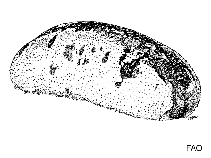Holothuria lessoni Massin, Uthicke, Purcell, Rowe & Samyn, 2009
Golden sandfish| Native range | All suitable habitat | Point map | Year 2050 |

|
| This map was computer-generated and has not yet been reviewed. |
| Holothuria lessoni AquaMaps Data sources: GBIF OBIS |
Classification / Names Tên thường gặp | Các synonym ( Các tên trùng) | CoL | ITIS | WoRMS
Holothuroidea | Holothuriida | Holothuriidae
Environment: milieu / climate zone / Mức độ sâu / distribution range Sinh thái học
Cùng sống ở rạn san hô; Mức độ sâu 0 - 25 m (Tài liệu tham khảo 108901), usually 0 - 10 m (Tài liệu tham khảo 108901). Tropical
Distribution Các nước | Các khu vực của FAO | Các hệ sinh thái | Những lần xuất hiện | Những chỉ dẫn
Indo-West Pacific: East Africa to Papua New Guinea and Australia.
Length at first maturity / Bộ gần gũi / Weight / Age
Chín muồi sinh dục: Lm ? range ? - ? cm Max length : 48.0 cm TL con đực/không giới tính; (Tài liệu tham khảo 80470); common length : 35.0 cm TL con đực/không giới tính; (Tài liệu tham khảo 80470); Khối lượng cực đại được công bố: 2.8 kg (Tài liệu tham khảo 122)
Life cycle and mating behavior Chín muồi sinh dục | Sự tái sinh sản | Đẻ trứng | Eggs | Sự sinh sản | Larvae
Main reference
Các tài liệu tham khảo | Người điều phối | Người cộng tác
Massin, C., S. Uthicke, S.W. Purcell, F.W.E. Rowe and Y. Samyn 2009 Taxonomy of the heavily exploited Indo-Pacific sandfish complex (Echinodermata: Holothuriidae). Zoological Journal of the Linnean Society 155:40-59. (Tài liệu tham khảo 80470)
IUCN Red List Status
(Tài liệu tham khảo 130435: Version 2025-1)
CITES status (Tài liệu tham khảo 108899)
CMS (Tài liệu tham khảo 116361)
Threat to humans
Human uses
Các nghề cá: tính thương mại cao
FAO - Các nghề cá: landings | FishSource |
Các công cụ
Thêm thông tin
Thành phần thức ăn
Thành phần thức ăn
Các động vật ăn mồi
Max. ages / sizes
Length-weight rel.
Length-length rel.
Length-frequencies
Mass conversion
Sự phong phú
Các nguồn internet
BHL | BOLD Systems | CISTI | DiscoverLife | FAO(Các nghề cá: ; publication : search) | Fishipedia | GenBank (genome, nucleotide) | GloBI | Gomexsi | Google Books | Google Scholar | Google | PubMed | Cây Đời sống | Wikipedia (Go, tìm) | Tạp chí Zoological Record



